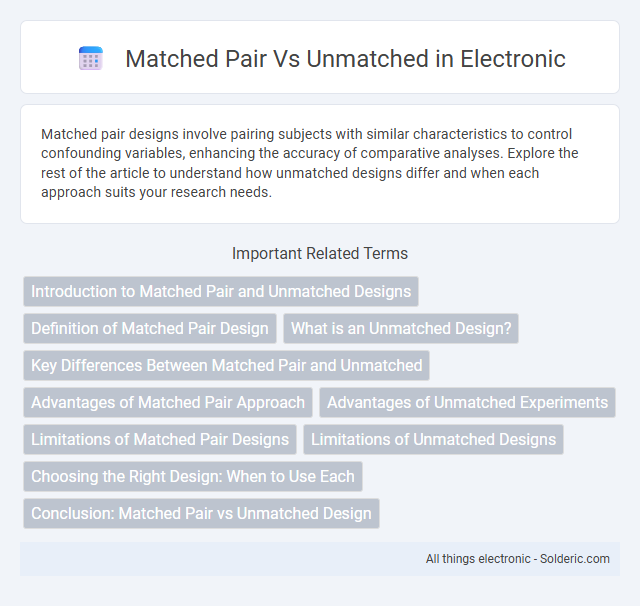Matched pair designs involve pairing subjects with similar characteristics to control confounding variables, enhancing the accuracy of comparative analyses. Explore the rest of the article to understand how unmatched designs differ and when each approach suits your research needs.
Comparison Table
| Aspect | Matched Pair | Unmatched |
|---|---|---|
| Definition | Subjects are paired based on similar characteristics before comparison. | Subjects are compared without any pairing or matching. |
| Purpose | Controls confounding variables by matching pairs. | Analysis performed on independent samples. |
| Data Dependency | Dependent data (paired observations). | Independent data (unpaired observations). |
| Statistical Tests | Paired t-test, McNemar's test. | Independent t-test, Chi-square test. |
| Sample Size | Requires equal number of pairs. | Sample sizes can differ between groups. |
| Advantages | Reduces variability, increases statistical power. | More flexible, simpler design. |
| Disadvantages | Complex to find matching pairs, limited generalizability. | More variability, potential confounding variables. |
Introduction to Matched Pair and Unmatched Designs
Matched pair designs involve pairing subjects based on similar characteristics to reduce variability and increase statistical power, often used in clinical trials and psychology studies. Unmatched designs treat subjects independently without pairing, providing simpler analysis but potentially greater variance due to subject heterogeneity. Your choice between matched pair and unmatched designs depends on study goals, sample size, and the importance of controlling confounding variables.
Definition of Matched Pair Design
Matched pair design involves pairing participants based on similar characteristics or matching each participant with themselves under different conditions, enabling direct comparison and controlling for confounding variables. Unmatched design assigns participants randomly without pairing, relying on group differences for analysis, which may introduce variability. Your choice impacts the study's internal validity and statistical power.
What is an Unmatched Design?
An unmatched design in research refers to a study where participants in different groups are independent and not paired based on specific characteristics. This design allows for greater sample size flexibility but may require more advanced statistical methods to control for confounding variables. Unmatched designs are commonly used in observational studies and randomized controlled trials where pairing is not feasible or necessary.
Key Differences Between Matched Pair and Unmatched
Matched pair designs involve pairing subjects based on similar characteristics to control for confounding variables, enhancing the accuracy of comparisons. Unmatched designs analyze independent groups without pairing, relying on randomization to balance differences across groups. Your choice between matched pair and unmatched depends on study goals and the need to control variability for more precise effect estimation.
Advantages of Matched Pair Approach
The Matched Pair Approach offers increased statistical efficiency by controlling for confounding variables through pairing similar subjects, which reduces variability and enhances the precision of treatment effect estimates. This method improves the validity of causal inferences by ensuring that comparisons are made between closely matched units, minimizing bias caused by heterogeneity. Furthermore, matched pair designs require smaller sample sizes than unmatched designs while maintaining adequate power, making them cost-effective for clinical trials and observational studies.
Advantages of Unmatched Experiments
Unmatched experiments simplify design and analysis by avoiding the complexities of pairing subjects, allowing greater flexibility in sample selection and often larger sample sizes. They facilitate straightforward statistical methods such as independent samples t-tests or chi-square tests, enhancing interpretability and reducing potential biases from incorrect matching. Furthermore, unmatched designs can better accommodate variability within groups, improving generalizability of results across diverse populations.
Limitations of Matched Pair Designs
Matched pair designs face limitations such as increased complexity in data collection and analysis, as each pair must be carefully matched on relevant variables to reduce confounding. You may encounter reduced sample sizes since suitable matches are not always available, potentially limiting the study's statistical power. These constraints can lead to difficulties in generalizing results to broader populations due to the selective nature of pairing.
Limitations of Unmatched Designs
Unmatched designs often face limitations such as increased variability and potential confounding due to lack of control over key variables between groups. These designs may reduce statistical power, making it harder to detect true effects compared to matched pair designs that closely pair participants based on relevant characteristics. Your study's validity could be compromised if unmatched groups differ significantly, leading to biased or less reliable results.
Choosing the Right Design: When to Use Each
Matched pair design is ideal when controlling for confounding variables by pairing subjects with similar characteristics, enhancing statistical power in studies with smaller sample sizes. Unmatched design suits scenarios with larger populations where random assignment balances groups, simplifying analysis and reducing logistical complexity. Selecting between matched and unmatched designs depends on study objectives, population heterogeneity, and available resources, optimizing validity and efficiency in experimental outcomes.
Conclusion: Matched Pair vs Unmatched Design
Matched pair designs control for individual differences by pairing subjects based on specific characteristics, enhancing the accuracy of comparisons in experimental studies. Unmatched designs analyze groups independently, which may introduce variability but are simpler to implement when pairing is not feasible. Your choice between matched pair and unmatched design should align with the study's goals, sample size, and the importance of controlling confounding variables.
Matched pair vs Unmatched Infographic

 solderic.com
solderic.com